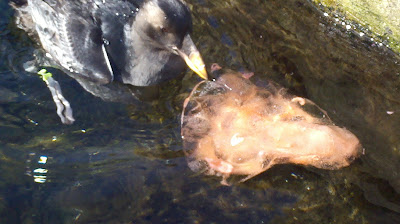So I know I was going to do this a long time ago, and update throughout my internship. As it were, this is more of a life update about me that'll be a couple of installments for you folks who don't have Facebook, and even some of you who do.
As many of you know, I was an intern with the Birds department at the Oregon Coast Aquarium. Based in Newport, Oregon, the aquarium is nestled in Yaquina Bay, from which the aquarium draws all its water. All wildlife at the aquarium is native to Oregon (with the exception of its sea otters, who were hunted to local extinction on the Oregon Coast). It's one of the biggest tourist destinations in Oregon, and originally rose to fame when it housed Keiko, the orca star of
Free Willy, from 1996 to 1998. A lot has changed about the aquarium since then, but it's definitely a top aquarium, in my humble and totally unbiased opinion, especially for a nonprofit organization.



The aquarium sports a lovely nature trail that offers excellent views of the estuary habitat that occurs naturally in Yaquina Bay. It's an excellent place from which to watch bird life, including Great Blue Herons, Bald Eagles, and countless (I literally mean countless) gulls and waterfowl.
Most people are interested in the aquarium's fine exhibits, though. Its indoor aquariums demonstrate examples of marine life from the sandy shores, rocky coast, and coastal waters, and cover habitats from tide pools to jetties to kelp forests. There's also an interactive area, mostly geared towards children but definitely enjoyable for an adult. Called "The Sea and Me," these exhibits feature some of the aquarium's smaller and more colorful fish, including clownfish, sea horses, and other charismatic coral reef fish, in addition to cichlids and cleaner shrimp. Some highlight animals include various species of rockfish, spider crabs, moray and wolf eels, and small sharks (Filetail Catshark and Horn shark). There's also a Giant Pacific Octopus who can be found outside in a secluded cave exhibit.






.
Then, it's outside to explore some of the Oregon Coast's charismatic megafauna. The aquarium is home to 3 species of marine mammals: California Sea Lions, Harbor Seals, and Sea Otters. These are incredibly popular places to be, especially around feeding time. The otters certainly make their presence known throughout the day, sounding like squeaky toys that can be heard from outside the aquarium. In fact, I thought they were dolphins when I heard them as I walked to the aquarium for the first time (goes to show how well-educated I am about marine mammals).
 |
| Harbor Seals |
 |
| Female California Sea Lion |
 |
| Sea Otter |
We move on to my personal favorite part of the aquarium, the birds. The OCAQ is home to an almost 8000 square foot, 34 foot tall aviary, which mostly houses seabirds of the auk family (Alcidae), but also a pair of Black Oystercatchers. The auk species represented here are the aloof but beautifully colored Pigeon Guillemots; the noisy and social Common Murres; everybody's favorite, the Tufted Puffins; and the silent but adorable Rhinocerous Auklets (easily my favorite species in the aviary). There's ample room for the approximately 95 seabirds that live here, and the exhibit is carefully tended by staff (I should know).
Those aren't the only birds who call the OCAQ home. Outside of the aviary, there's a smaller exhibit where Olive and Ichabod, the aquarium's brother and sister pair of Turkey Vultures live. Many who come here question why Turkey Vultures are featured at an aquarium, but they're a very important part of the coastal ecosystem, not just in Oregon but throughout the New World.
 |
| Winter plumage Pigeon Guillemot |
 |
| Breeding plumage Pigeon Guillemot |
 |
| Common Murre |
 |
| Halfway-into breeding plumage Tufted Puffin |
 |
| Rhinocerous Auklet |
 |
| Ichabod, one of the OCAQ's Turkey Vultures |
Finally, we come to the Passages of the Deep. This area used to house Keiko, but has since been developed into several walk-through exhibits detailing life deeper in the Pacific Ocean. Orford Reef is home to bull kelp forests, where rockfish of a wide variety of sizes and colors can be found. Next is Halibut Flats, home to (perhaps unsurprisingly) the Pacific Halibut, but also to skates, lingcod, and a few massive sturgeon. Finally, the Open Sea is perhaps the most popular section of Passages of the Deep, because it's home to a creature that mystifies, surprises, and unfortunately in many cases, scares us: sharks. Broadnose Seven-Gill sharks, Leopard Sharks, and Spiny Dogfish all call the Open Sea home, and they share it with magnificent Bat Rays, as well as schools of anchovies and mackerel.





The aquarium offers many opportunities for the public. Volunteers form an integral part of the OCAQ force, as one might expect for a nonprofit organization, and can be found just about anywhere in the aquarium during open hours, interpreting for the public. They can also be found behind the scenes, helping prepare animal diets and keeping husbandry areas tidy. Students studying Marine Biology often come here to learn practical animal care. The husbandry departments (Mammals, Birds, and Fish) also offer 3-month long husbandry internships year-round.
That, of course, is where my story begins.































